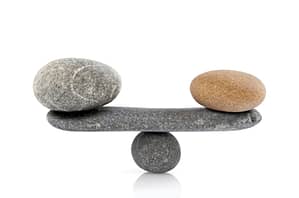How to Create A Balanced Relationship
 Whether they are married, in a relationship or single – most people would say they want to have a balanced relationship with their significant other. But what does a balanced relationship look like and how do you maintain it?
Whether they are married, in a relationship or single – most people would say they want to have a balanced relationship with their significant other. But what does a balanced relationship look like and how do you maintain it?
The fact is, we all relate to people in different ways: Dependently (or codependently), Independently and Interdependently.
Dependent/codependent:
In these relationships one person sets aside his or her personal welfare to maintain the relationship. This dynamic implies that the codependent person in the relationship can’t survive independently of the other person.
Independent:
In this configuration, the couple lives mostly separate lives. For example, they have different friends, are rarely together and make decisions autonomously. They may live separately as well and they are fine with that arrangement.
Interdependent:
In this type of relationship, two people are intimate with one another but don’t compromise or sacrifice themselves or their values. This dynamic is about collaboration and cooperation. Each person is self-reliant (physically, emotionally, financially, etc.) and, simultaneously, responsible to the other.
While it’s possible to find happiness, at least temporarily, in all three types of relationships, the Interdependent relationship is generally considered the model for a balanced relationship.
What do you do if you don’t consider your relationship to be balanced? With a little information and effort it’s possible to attain a balanced relationship.
1. Find Inner Balance by:
• Focusing on what you can control (your thoughts, feelings and actions) not what you can’t (others’ thoughts, feelings and actions).
• Noticing how you feel and, as clearly and calmly as you can, communicating those feelings.
• Recognizing and owning your issues, which will help you recognize your partner’s as well. You can be empathic and supportive without having to “fix” everything.
2. Create and Maintain a Balanced Relationship by:
• Staying present and empathic even when your partner is upset.
• Stepping back from conflicts to avoid escalation, assess the problem and make positive changes.
• Reframing the actions/reactions of your partner. For example, seeing a loved one as anxious and fearful, instead of cruel and controlling, paves the way for a more sympathetic, less confrontational approach.
• Being a good listener and focusing on the only person you can change—yourself.
3. Recognize and change old emotional patterns and blocked energetic pathways by:
• Writing down negative feelings that manifest themselves throughout your day. Then rewrite them in a positive light.
• Become aware of “triggers” that influence your mood. Many times just the awareness will lead to your ability to not be influenced by them – putting you in control.
• Write down up to 10 positive affirmations you would like to see manifested in your relationship and post them where you will see and read them often (ie. Bathroom mirror, near your computer screen, etc.)
Keep in mind that balance, like a relationship, is dynamic not static. It’s impossible to keep balance 100% of the time in every situation. Even a balanced relationship can, at times, feel like more work than play.
Remember, sometimes the focus will be more on you, other times more on your partner, and still other times when what’s best for “us” needs the focus rather than either individual.
Like a wave, there is an ebb and flow to relationships. But once we are aware of what balanced relationships look like we can better manage that dynamic.
Would you like to pull out those threads of negative emotional patterns and release blocked energy to allow your Spirit to be more open to and/or attract the relationship you desire?
This month I am having a group phone session focusing on Romantic Relationships. For those of you in a relationship this call will be focused on your relationship with your partner. If you are single we will also be releasing issues blocking you from attracting your ideal mate. So really, this call is for everyone!
Here’s what we’ll be working on:
• Releasing negative dependent/co-dependent/independent false beliefs.
• Shifting thought patterns to accept and attract an interdependent relationship.
• Instilling positive affirmations to support your raised energetic attractiveness for the relationship you desire.
To learn more about group phone sessions and to sign-up, go here.
Author’s content used under license, © 2011 Claire Communications


Leave a Reply
Want to join the discussion?Feel free to contribute!